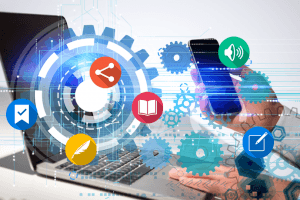How Can You Transform Your LMS Into An Intelligent Performance Engine
The world is not flat. And neither is learning. Your Learning Management System, just like our lives, cannot be one-sided.
We no longer live in a one-dimensional setting where a student goes to the classroom to sit for an hour and learn a new skill. We live in a dynamic world where technology is seamlessly integrated into our everyday lives. And the expectations for learning systems are evolving in the same way.
So, what does this mean for your Learning Management System?
Your organization must leverage new technology and innovations to improve your users’ experiences with your Learning Management System. You must also adapt to the changing expectations users have about their preferred learning methods.
Here are three fundamental strategies you should be leveraging to help transform your learning program from more than just a Management System and into an “Intelligent Performance Engine,” or else, an IPE.
1. Personalize Your Platform
Personalization is key. You should have a personalized User Interface that is easy to use. Upon login, courses, to-do’s and accomplishments should be visible and accessible. Search bars should be geared towards a specific user’s training requirements. The process should be easy.
But, beyond that, a system should be integrated with an individual user’s needs, in other words what are their learning preferences? How do they learn the best? What certificate programs do they need to complete? What other courses might this person gain from taking? Has this person had any accidents on the job recently? If so, what training is needed to prevent this from happening again?
It’s important for products to allow clients and users to easily visualize their data and take immediate action on recommendations to achieve measurable improvements in business and learning results.
2. Leverage Data And Analytics
The amount of data collected and stored by organizations around the world is mind boggling with some sources citing 2.7 Zettabytes of data existing in the universe today. The ability to leverage this data goes along with personalization. Intelligent solutions should recommend courses based on the needs of the individual users. Systems need to be able to easily "talk to each other" in order to synthesize information and prescribe relevant learning plans based on data.
Recommendations should be triggered by metrics that dictate learning needs. This, in turn, creates actionable insight that helps the learner identify areas he or she may have not be aware of, but that are needed to improve performance. Another benefit is that learners have course and topic suggestions made to help them, an advantage of in-person learning that had previously been missing with early online education but that is now available through intelligent systems.
Solutions need to extend past learning based on annual requirements and utilize data from both internal and external programs to create actionable training plans to increase organization and individual performance.
3. Implement A Multi-Platform Approach
Smartphone users have exceeded two billion worldwide and that number is increasing as the millennial workforce drives a demand for mobile learning and microlearning, two approaches that provide numerous advantages to learners. Online learning has always benefitted users by allowing them to complete courses on their own schedules. Its convenience has increased participation and made education easier to incorporate into daily life.
But now, with the development of microlearning and mobile apps, users have the added opportunity for contextualized learning that allows them to refresh on quick topics, when they need it, and apply it right away, maximizing comprehension.
Having quick "bite-sized" learning pieces of courses available in real-time that can be applied immediately resonates better with the user, creates experiential learning experiences and increases retention of knowledge and skills long-term. With the secondary nature of mobile technology, it is only natural that this be leveraged in learning.
Learning and performance systems must have an integrated and personalized multi-platform approach that puts the individual user’s needs at the center of the learning program. It’s about helping people access information when they need, where they need it. It’s about improving their experience and making their lives better.
As learning providers, we need to make sure that we are leveraging the synchronicity that the latest technological tools and advancements can offer. This is how we can best optimize user experience and allow for maximum learning and comprehension. This is the best way to help our learners optimize their own performance. Antiquated, one-dimensional learning systems simply will no longer do.
